Speech Communication System Based on Piezoelectric Electret Mechanical Antenna
Abstract
:Featured Application
Abstract
1. Introduction
- A mechanical antenna communication hardware system is designed;
- A three layer hierarchical mechanical antenna communication protocol is proposed;
- A software system with an extensible modular architecture is proposed.
2. Materials and Methods
2.1. Mechanism of the PZT-42 Mechanical Antenna
2.2. Speech Communication System Design
2.2.1. Hardware System
2.2.2. Communication Protocol
2.2.3. Software System
3. Results
3.1. Transmitter Side
- t1 Message Input: The user says “hello” to the microphone, and the transmitter terminal recognizes the user’s speech and converts it into text;
- t2 Message Processing and Encoding: This message “hello” is processed and converted to a binary code. If the user has defined a method to process the data, the data is processed first. Otherwise, the message will be encoded directly. For example, the process of the original message “hello” without extra processing is as follows:
- Obtain the ASCII code of “hello”, expressed in hexadecimal as “0x68656C6C6F”;
- Append control information such as the frame header and frame tail to get the complete transmitting sequence: “0xFF0168656C6C6F20” in hexadecimal;
- Convert to binary code to get the final binary string to be transmitted;
- t3 Message Transmitting: As shown in Figure 7a, the binary string obtained in the previous step is used as the source signals. The transmitter terminal controls the AFG and modulates the signals. This system utilizes ASK modulation to modulate binary 1 as a sine wave at 167.34 kHz with 16,734 repeated cycles, while binary 0 is represented by the absence of any signal transmission. Figure 7b depicts the message’s final modulated signals. These signals are amplified and fed directly to the mechanical antenna, which then radiates into free space.
3.2. Receiver Side
- r1 Message Receiving: The loop antenna receives and transmits the signals to LIA. The receiving terminal continuously reads the voltage value of the frequency on the communicating channel from LIA and judges the bit value. A received signal higher than the reference voltage represents binary 1, and a received signal lower than the reference voltage represents binary 0. When a string of binary 1 is identified, the receiver terminal begins signal reception. The modulated signals received by LIA are shown in Figure 8a. As illustrated in Figure 8b, the LIA filters out the noise and demodulates the received signals to obtain the final demodulated signals. At the receiver terminal, the demodulated signals are sampled and judged according to the reference voltage, and the complete transmitting binary string is ultimately obtained;
- r2 Message Decoding and Inverse Processing: If the user defines additional data processing work such as encryption and compression, the corresponding inverse processing work of decryption and decompression should also be performed. Since there is no additional user-defined message processing function, the receiver terminal operates as follows:
- Decode the binary string and obtain the results: “0xFF0168656C6C6F20” in hexadecimal;
- Obtain the payload data of the message “0x68656C6C6F” located by the frame header and frame tail;
- Convert it into the original message according to ASCII encoding rules: “hello”;
- r3 Message Output: Show the received message “hello” on the receiver side.
4. Conclusions
Author Contributions
Funding
Institutional Review Board Statement
Informed Consent Statement
Data Availability Statement
Conflicts of Interest
References
- Idir, N.; Weens, Y.; Franchaud, J.J. Skin Effect and Dielectric Loss Models of Power Cables. IEEE Trans. Dielect. Electr. Insul. 2009, 16, 147–154. [Google Scholar] [CrossRef]
- Chowdhury, M.Z.; Shahjalal, M.; Hasan, M.K.; Jang, Y.M. The Role of Optical Wireless Communication Technologies in 5G/6G and IoT Solutions: Prospects, Directions, and Challenges. Appl. Sci. 2019, 9, 4367. [Google Scholar] [CrossRef]
- Cohen, M.B.; Inan, U.S.; Paschal, E.W. Sensitive Broadband ELF/VLF Radio Reception With the AWESOME Instrument. IEEE Trans. Geosci. Remote 2010, 48, 3–17. [Google Scholar] [CrossRef]
- García, R.M.; Novas, N.; Alcayde, A.; El Khaled, D.; Fernández-Ros, M.; Gazquez, J.A. Progress in the Knowledge, Application and Influence of Extremely Low Frequency Signals. Appl. Sci. 2020, 10, 3494. [Google Scholar] [CrossRef]
- Gussen, C.M.G.; Diniz, P.S.R.; Campos, M.L.R.; Martins, W.A.; Costa, F.M.; Gois, J.N. A Survey of Underwater Wireless Communication Technologies. J. Commun. Inf. Syst. 2016, 31, 242–255. [Google Scholar] [CrossRef]
- Hattori, K. ULF Geomagnetic Changes Associated with Large Earthquakes. Terr. Atmos. Ocean. Sci. 2004, 15, 329. [Google Scholar] [CrossRef]
- Rowe, H. Extremely Low Frequency (ELF) Communication to Submarines. IEEE Trans. Commun. 1974, 22, 371–385. [Google Scholar] [CrossRef]
- Zhima, Z.; Hu, Y.; Shen, X.; Chu, W.; Piersanti, M.; Parmentier, A.; Zhang, Z.; Wang, Q.; Huang, J.; Zhao, S.; et al. Storm-Time Features of the Ionospheric ELF/VLF Waves and Energetic Electron Fluxes Revealed by the China Seismo-Electromagnetic Satellite. Appl. Sci. 2021, 11, 2617. [Google Scholar] [CrossRef]
- Harriman, S.K.; Paschal, E.W.; Inan, U.S. Magnetic Sensor Design for Femtotesla Low-Frequency Signals. IEEE Trans. Geosci. Remote 2010, 48, 396–402. [Google Scholar] [CrossRef]
- Pfeiffer, C. Fundamental Efficiency Limits for Small Metallic Antennas. IEEE Trans. Antenn. Propag. 2017, 65, 1642–1650. [Google Scholar] [CrossRef] [Green Version]
- Xu, J.; Zhao, M.; Zhang, R.; Lei, M.; Gao, X.; Huang, S.; Bi, K. A Wideband F-Shaped Microstrip Antenna. Antenn. Wirel. Propag. Lett. 2017, 16, 829–832. [Google Scholar] [CrossRef]
- Chen, H.; Liang, X.; Dong, C.; He, Y.; Sun, N.; Zaeimbashi, M.; He, Y.; Gao, Y.; Parimi, P.V.; Lin, H.; et al. Ultra-Compact Mechanical Antennas. Appl. Phys. Lett. 2020, 117, 170501. [Google Scholar] [CrossRef]
- Yang, S.; Xu, J.; Guo, M.; Zhang, B.; Lan, C.; Li, H.; Bi, K. Progress on Very/Ultra Low Frequency Mechanical Antennas. ES Mater. Manuf. 2021, 16, 1–12. [Google Scholar] [CrossRef]
- Burch, H.C.; Garraud, A.; Mitchell, M.F.; Moore, R.C.; Arnold, D.P. Experimental Generation of ELF Radio Signals Using a Rotating Magnet. IEEE Trans. Antenn. Propag. 2018, 66, 6265–6272. [Google Scholar] [CrossRef]
- Fawole, O.C.; Tabib-Azar, M. An Electromechanically Modulated Permanent Magnet Antenna for Wireless Communication in Harsh Electromagnetic Environments. IEEE Trans. Antenn. Propag. 2017, 65, 6927–6936. [Google Scholar] [CrossRef]
- Guo, M.; Wen, X.; Yang, S.; Xu, J.; Pan, X.; Bi, K. Extremely-Low Frequency Mechanical Antenna Based on Vibrating Permanent Magnet. Eng. Sci. 2021, 16, 387–392. [Google Scholar] [CrossRef]
- Xu, J.; Cao, J.; Guo, M.; Yang, S.; Yao, H.; Lei, M.; Hao, Y.; Bi, K. Metamaterial Mechanical Antenna for Very Low Frequency Wireless Communication. Adv. Compos. Hybrid Mater. 2021, 4, 761–767. [Google Scholar] [CrossRef]
- Cao, J.; Yao, H.; Pang, Y.; Xu, J.; Lan, C.; Lei, M.; Bi, K. Dual-Band Piezoelectric Artificial Structure for Very Low Frequency Mechanical Antenna. Adv. Compos. Hybrid Mater. 2022, 5, 410–418. [Google Scholar] [CrossRef]
- Dong, C.; He, Y.; Li, M.; Tu, C.; Chu, Z.; Liang, X.; Chen, H.; Wei, Y.; Zaeimbashi, M.; Wang, X.; et al. A Portable Very Low Frequency (VLF) Communication System Based on Acoustically Actuated Magnetoelectric Antennas. IEEE Antenn. Wirel. Propag. 2020, 19, 398–402. [Google Scholar] [CrossRef]
- Zhou, W.; Chen, P.; Pan, Q.; Zhang, X.; Chu, B. Lead-Free Metamaterials with Enormous Apparent Piezoelectric Response. Adv. Mater. 2015, 27, 6349–6355. [Google Scholar] [CrossRef]
- Zhang, X.; Liu, J.; Chu, M.; Chu, B. Flexoelectric Piezoelectric Metamaterials Based on the Bending of Ferroelectric Ceramic Wafers. Appl. Phys. Lett. 2016, 109, 072903. [Google Scholar] [CrossRef]
- Damjanovic, D. Stress and Frequency Dependence of the Direct Piezoelectric Effect in Ferroelectric Ceramics. J. Appl. Phys. 1997, 82, 1788–1797. [Google Scholar] [CrossRef]
- Xu, Z.; Shan, X.; Chen, D.; Xie, T. A Novel Tunable Multi-Frequency Hybrid Vibration Energy Harvester Using Piezoelectric and Electromagnetic Conversion Mechanisms. Appl. Sci. 2016, 6, 10. [Google Scholar] [CrossRef]
- Xu, J.; Li, Z.; Pan, X.; Wen, X.; Cao, J.; Gong, W.; Yang, S.; Lei, M.; Yao, F.; Bi, K. Ultra-Wideband Electrostrictive Mechanical Antenna. Adv. Funct. Mater. 2022, 2210868. [Google Scholar] [CrossRef]
- Bickford, J.A.; Duwel, A.E.; Weinberg, M.S.; McNabb, R.S.; Freeman, D.K.; Ward, P.A. Performance of Electrically Small Conventional and Mechanical Antennas. IEEE Trans. Antenn. Propag. 2019, 67, 2209–2223. [Google Scholar] [CrossRef]
- Zimmermann, H. OSI Reference Model—The ISO Model of Architecture for Open Systems Interconnection. IEEE Trans. Commun. 1980, 28, 425–432. [Google Scholar] [CrossRef]
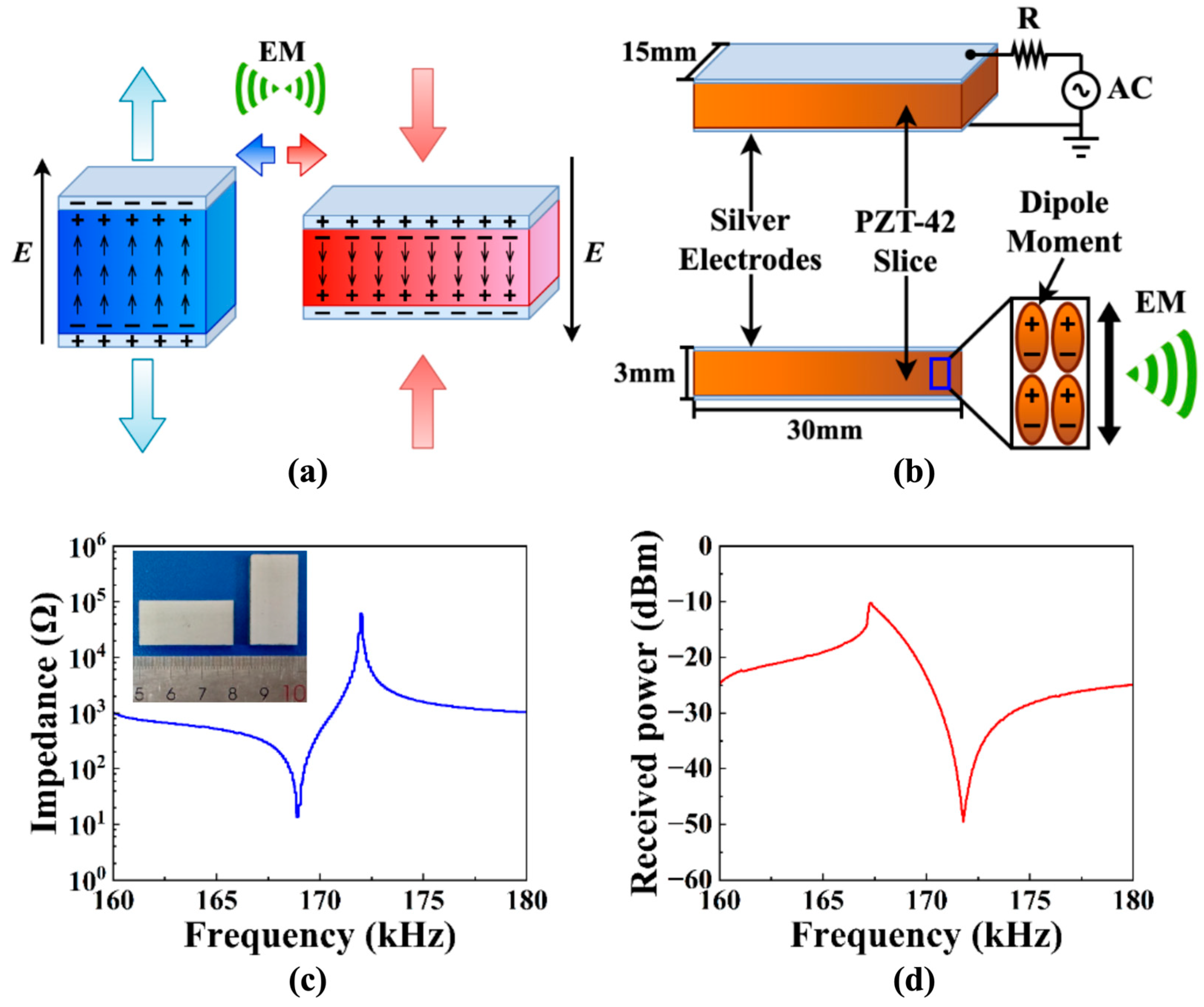
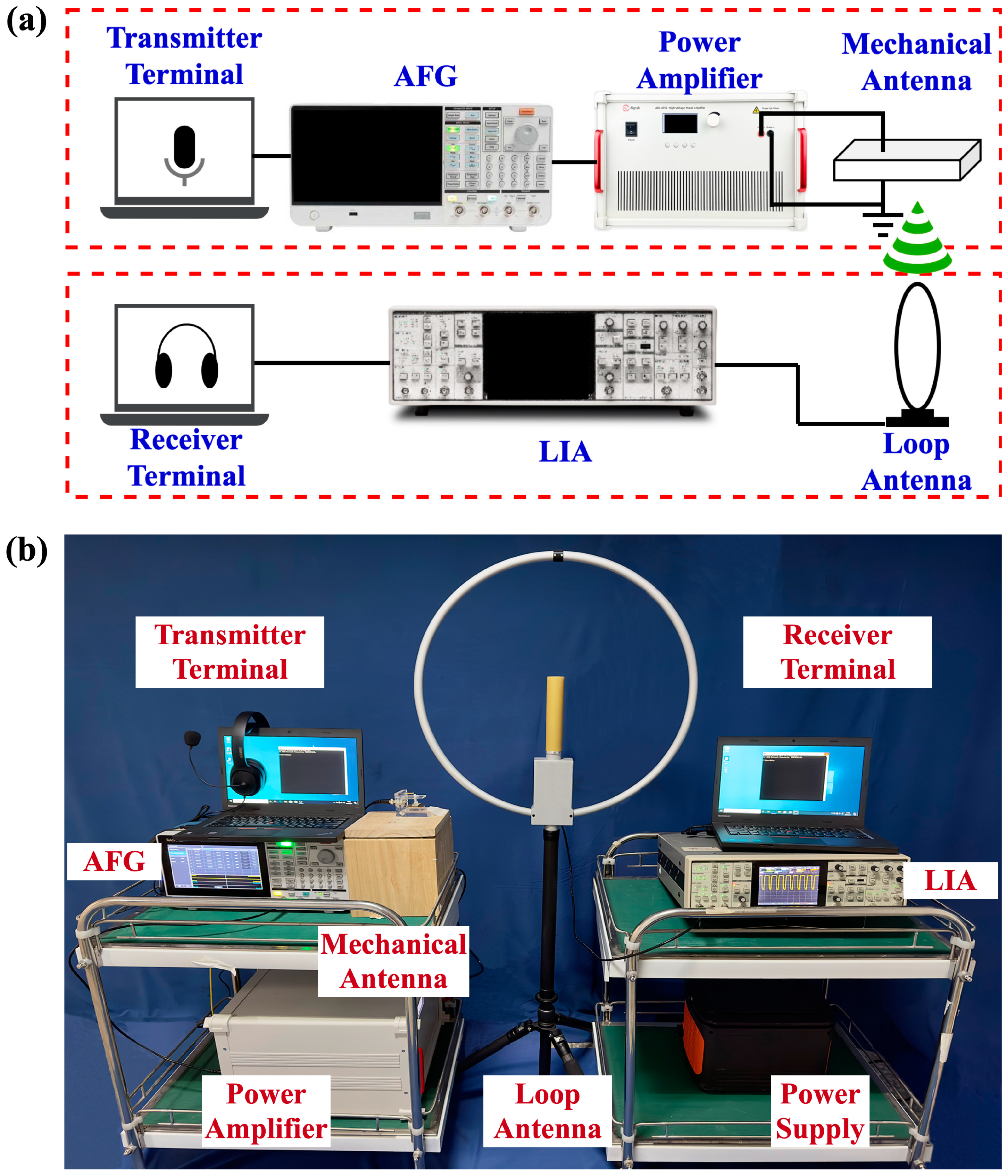
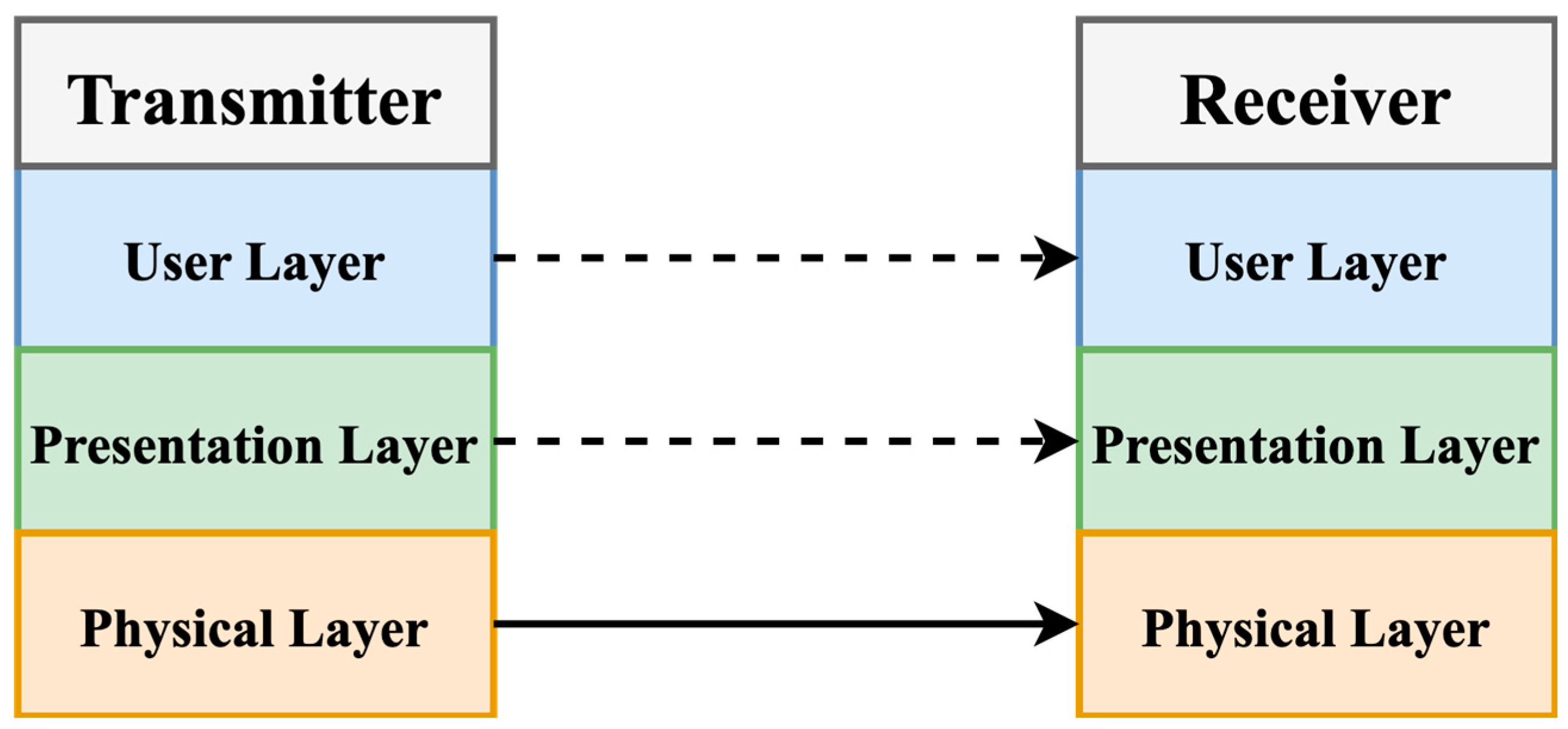


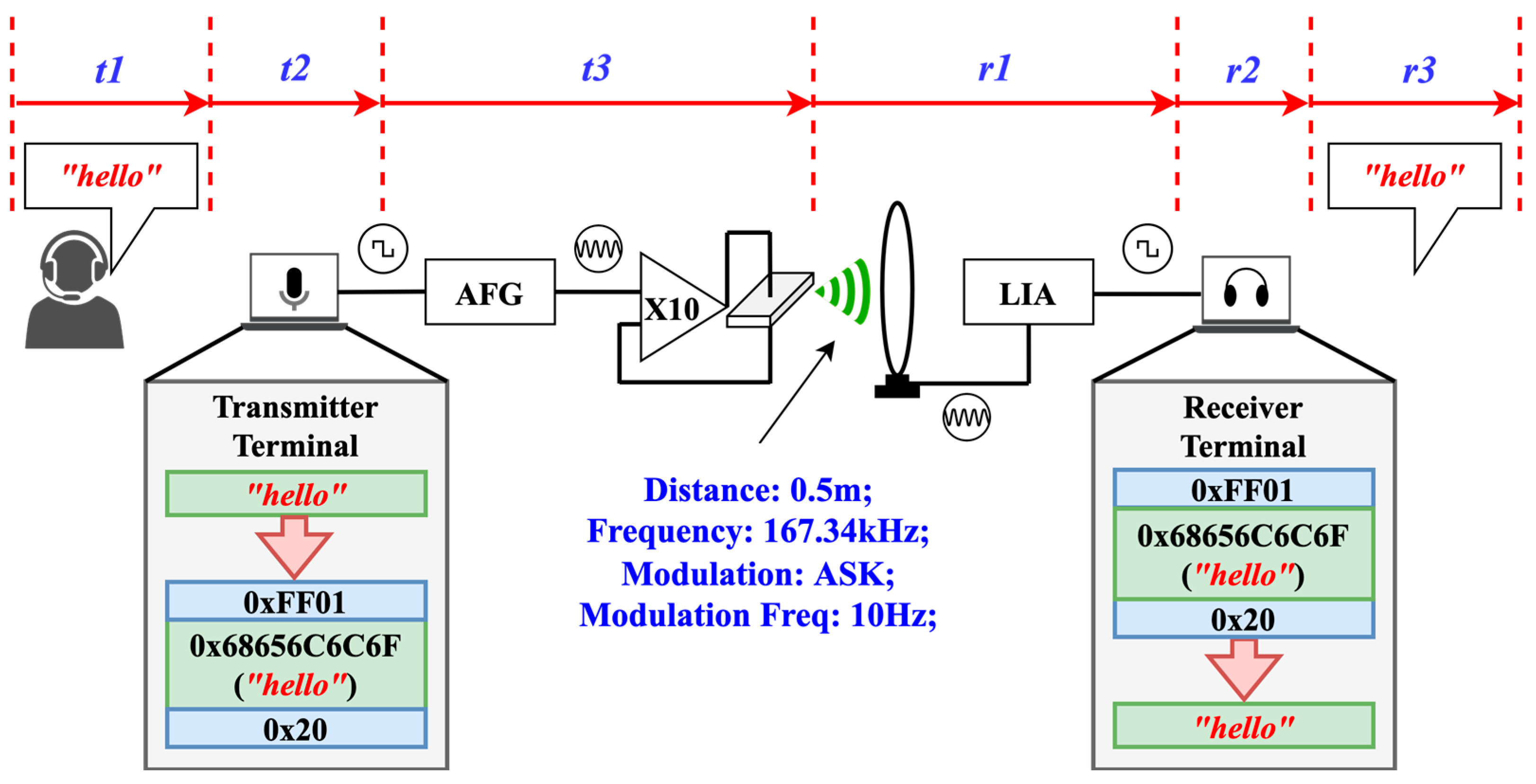

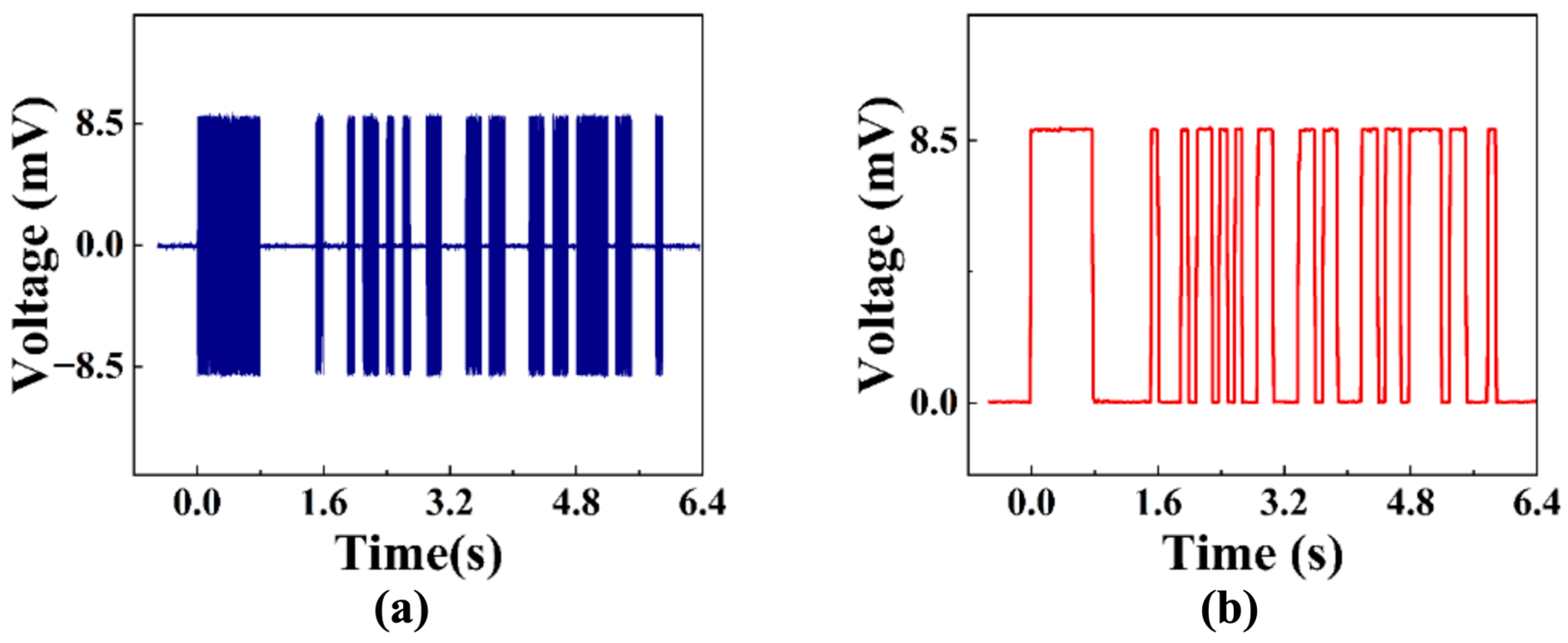
Disclaimer/Publisher’s Note: The statements, opinions and data contained in all publications are solely those of the individual author(s) and contributor(s) and not of MDPI and/or the editor(s). MDPI and/or the editor(s) disclaim responsibility for any injury to people or property resulting from any ideas, methods, instructions or products referred to in the content. |
© 2023 by the authors. Licensee MDPI, Basel, Switzerland. This article is an open access article distributed under the terms and conditions of the Creative Commons Attribution (CC BY) license (https://creativecommons.org/licenses/by/4.0/).
Share and Cite
Wang, S.; Yang, J.; Lu, P.; Yang, S.; Guo, L.; Hao, Y.; Huang, K.; Xu, J. Speech Communication System Based on Piezoelectric Electret Mechanical Antenna. Appl. Sci. 2023, 13, 2332. https://doi.org/10.3390/app13042332
Wang S, Yang J, Lu P, Yang S, Guo L, Hao Y, Huang K, Xu J. Speech Communication System Based on Piezoelectric Electret Mechanical Antenna. Applied Sciences. 2023; 13(4):2332. https://doi.org/10.3390/app13042332
Chicago/Turabian StyleWang, Shuopu, Jing Yang, Ping Lu, Shaolong Yang, Limin Guo, Yanan Hao, Kai Huang, and Jianchun Xu. 2023. "Speech Communication System Based on Piezoelectric Electret Mechanical Antenna" Applied Sciences 13, no. 4: 2332. https://doi.org/10.3390/app13042332
APA StyleWang, S., Yang, J., Lu, P., Yang, S., Guo, L., Hao, Y., Huang, K., & Xu, J. (2023). Speech Communication System Based on Piezoelectric Electret Mechanical Antenna. Applied Sciences, 13(4), 2332. https://doi.org/10.3390/app13042332






